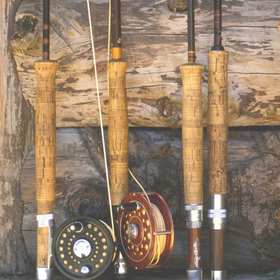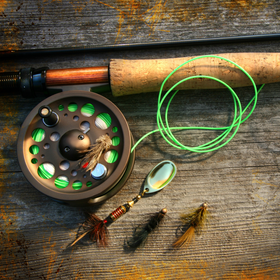One of the most popular fly fishing techniques is called dead drift. Dead drifting is primarily done when fly fishing with nymphs, and are fishing slots, seams or smaller rivers. It is an effective technique that any fly fisher should have in their repotorie of fly fishing techniques. And is particularly effective, when nothing is happening on the surface of the water.
When to Use It
Dead drifting is primarily a trout fishing technique. But is also effective when fishing for steelhead. Especially when targeting fish that may be lying in any of the regions mentioned above. It is also effective for low water, when fish might be holing up under ledges close to the bank. For trout, one must remember that free floating nymphs are at the mercy of the currents of the river. Many a trout make a living at lying facing upstream, waiting for their meals to come drifting by.
Applying the Technique
The technique does usually require a strike indicator. Placed well above the fly and below the actual fly line. A strike indicator is invaluable in detecting strikes sub-surface. I prefer to ‘set’ the hook on any ‘abnormal’ movement. Often times strikes while dead drifting are ridicuously subtle. I ususally use Palsa Pinch-On Strike Indicators, as they are very light, so as not to interfer with casting. Yet they float well, and even if you sink your fly deep, they can be seen under the water surface, and still detect strikes.
The dead drift technique, is accomplished this way. First find the water you want your fly to drift through. And cast upstream for this spot. Mending your line to create a drag free float, and sometimes even picking up line off the water, will aid in your nymph imiatating a free floating real nymph. Treat your strike indicator like a dry fly, as if there is drag on it, there will be drag on your nymph. Casting upstream will allow your fly time to sink before it gets to the targeted strecth of water. Xink will help this happen, and many nypmh fly fishers find it invaluable.
Allow your fly to drift unencumbered until it is directly below you. Or as close to that as possible. Allow the nymph to rise slightly to imitate an emerger. Many times your nymph will be followed all the way down to this spot, only to finally be hit. If nothing happens, lift your nymph and try again.
Advanced Techniques
Once you have the knack of drifting your nymph while not creating a drag, yet managing your line well enough to set the hook when required, there are a couple of twists, that often times result in more fish. One is, to slightly raise your rod tip when drifting through your prime water. This often times will entice stubborn fish, who mistake this for an emerging nymph.
The second technique was first introduced to me in Montana, but is now used everywhere. It calls for the wading angler to cast directly upstream from their position. After casting, the fly fisher must strip in the line as it comes right at you. Allow the fly to float past you a few feet if possible. One of my favorite parts of this technique, is the amount of fish caught virtually right at my feet. Picking fairly fast well-oxygenated water, and wading stealthily, I often catch fist within two feet of my own!
Dead drifting can be done year around, providing you have water that is open year around. And can provide the patient fly fisher with some great fly fishing action, when no other technique would.




